This is the earlier 'machine sensing' alternator where the voltage is regulated according to the voltage on the output terminal of the alternator - the '+' terminal. Under high current loads it can result in a reduced battery voltage as some of the alternator output is 'lost' in the wiring to the battery cable terminal on the stater solenoid:

A later system used 'battery sensing' where the voltage regulator monitored the voltage at the battery cable via an additional BATT+ terminal and 'sense' wire connected to the battery cable at the solenoid. This delivers the correct voltage to the battery and the rest of the cars electrics by causing the alternator to deliver a higher voltage to compensate for the 'lost' voltage in the output wiring:

Subsequently the alternators became 'machine sensing' again but reduced the lost voltage by doubling-up on the output wiring to give more current carrying capacity. There are two types of 4TR external regulator for the 16AC alternator - one with three terminals and one with four. The three-teminal regulator is machine sensing and the four-terminal battery sensing which has an additional 'sense' wire to the starter solenoid.
What's inside and how it's components function: There is a field winding on the armature to generate a magnetic field, three fixed stator windings to provide the output, a diode pack consisting of nine diodes, and a voltage regulator. For connection to the outside world it has the positive 12v output terminal, an IND terminal, an earth through it's physical mounting to the engine, and in battery sensing applications an additional BATT+ terminal.
Unlike a dynamo which has its field windings fixed to the dynamo casing and output windings on the armature, the alternator is the other way round. This is because the armature brushes on a dynamo limit the maximum current that can flow both because of the resistive nature of the graphite or carbon brushes, and because they are running on a commutator which is continually connecting and disconnecting current which creates arcing, and high current damages the brushes and the commutator over time. By reversing the function even though graphite or carbon brushes are still used in an alternator they are running on continuous slip-rings rather than a commutator so arcing is eliminated and field current is much less than output current. Another benefit is that because the field-wound armature of the alternator has a significantly lower mass or weight than the output-wound armature of a dynamo it has a higher maximum rpm. This is utilised by the alternator having a smaller diameter pulley than the dynamo so it spins faster for a given engine speed, which also increases output. The downside of all this is that alternating current (AC) is generated in the stator of an alternator (hence its name) rather than the direct current (DC) from the commutator of a dynamo. AC is no good for charging a battery and operating many automotive electrical systems, so it has to be 'rectified' to DC which is the job of the diode pack. But first, the stator or output windings.
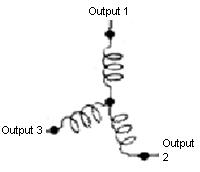 Whilst the field winding is a simple coil of wire wound onto the armature, the stator is attached to the body of the alternator and consists of three coils, connected in 'star' formation i.e. one end of the three coils are connected together, and the other ends provide three AC outputs. Because of the way the three coils are positioned and interconnected they generate AC in three different phases, i.e. three overlapping positive pulses of current and three negative for each magnetic pulse from the armature. Additionally the armature has 12 poles, each of which generates an output pulse in the stator windings, so generating 36 output cycles of AC for each revolution of the armature:
Whilst the field winding is a simple coil of wire wound onto the armature, the stator is attached to the body of the alternator and consists of three coils, connected in 'star' formation i.e. one end of the three coils are connected together, and the other ends provide three AC outputs. Because of the way the three coils are positioned and interconnected they generate AC in three different phases, i.e. three overlapping positive pulses of current and three negative for each magnetic pulse from the armature. Additionally the armature has 12 poles, each of which generates an output pulse in the stator windings, so generating 36 output cycles of AC for each revolution of the armature:
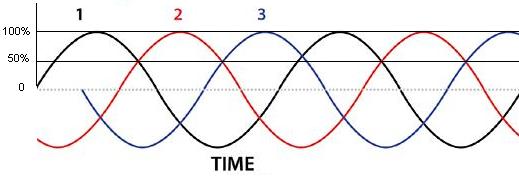
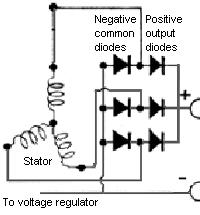 As said AC is no good for automotive electrics, and this is where the diode pack comes in. There are three positive output diodes, three positive control diodes, and three negative diodes. The negative diodes are used for both output and control. Separate positive diodes are needed as they go to different parts of the alternator. The diodes are connected such that negative half-cycles of output are converted to positive half-cycles - full-wave rectification, so now we get 72 pulses of positive voltage for each rotation of the armature, which gives a much steadier DC current flow. The positive output diodes are all connected to the positive output terminal of the alternator and the negative diodes are all connected to earth:
As said AC is no good for automotive electrics, and this is where the diode pack comes in. There are three positive output diodes, three positive control diodes, and three negative diodes. The negative diodes are used for both output and control. Separate positive diodes are needed as they go to different parts of the alternator. The diodes are connected such that negative half-cycles of output are converted to positive half-cycles - full-wave rectification, so now we get 72 pulses of positive voltage for each rotation of the armature, which gives a much steadier DC current flow. The positive output diodes are all connected to the positive output terminal of the alternator and the negative diodes are all connected to earth:

There is still quite a lot of 'ripple' in the output voltage, but when connected to a 12v car battery this ripple is smoothed to become to all intents and purposes a steady voltage, and it is this steady voltage that powers all the cars components. This is why an engine with an alternator should never be run without a battery connected, as this further smoothing action is lost, and some quite high voltage spikes can be generated which are capable of damaging electronic components at least, and may even blow bulbs.
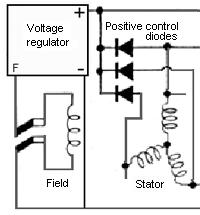 The three positive control diodes feed voltage to one side of the field winding, the other side of the field being connected to the voltage regulator. The voltage regulator 'sees' the voltage on the alternator output terminal (machine sensing) or via the 'sense' wire on the BATT+ terminal (battery sensing) the voltage on the battery cable on the starter solenoid. Changes in electrical loads from the car changes the current being drawn from the alternator, which because the alternator stator windings have resistance causes a certain amount of voltage to be 'lost' inside the alternator. As the current increases - more loads switched on - the lost voltage increases, which means the output voltage reduces, and vice-versa. Left to its own devices there would be huge variations in output voltage with changing electrical load which is undesirable, ideally we want to maintain a constant voltage at all times.
The three positive control diodes feed voltage to one side of the field winding, the other side of the field being connected to the voltage regulator. The voltage regulator 'sees' the voltage on the alternator output terminal (machine sensing) or via the 'sense' wire on the BATT+ terminal (battery sensing) the voltage on the battery cable on the starter solenoid. Changes in electrical loads from the car changes the current being drawn from the alternator, which because the alternator stator windings have resistance causes a certain amount of voltage to be 'lost' inside the alternator. As the current increases - more loads switched on - the lost voltage increases, which means the output voltage reduces, and vice-versa. Left to its own devices there would be huge variations in output voltage with changing electrical load which is undesirable, ideally we want to maintain a constant voltage at all times.
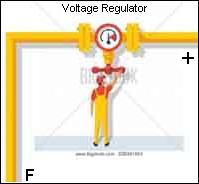 The voltage regulator is effectively a variable resistance (or control valve) between the field winding and earth. As more electrical loads on the car are switched on and output voltage is seen to drop, the voltage regulator senses that and reduces the resistance in series with the field winding allowing more current to flow. This increases the magnetic field around the stator and hence increases the output voltage. Conversely as electrical loads are switched off and current through the alternator reduces, the output voltage rises. The voltage regulator increases the resistance in series with the field winding which reduces the current in the field, which reduces the magnetic field and hence the output voltage. This increasing and reducing of current through the field maintains the output voltage at about 14.5v, which supplies all the cars electrical loads as well as trickle-charging the battery.
The voltage regulator is effectively a variable resistance (or control valve) between the field winding and earth. As more electrical loads on the car are switched on and output voltage is seen to drop, the voltage regulator senses that and reduces the resistance in series with the field winding allowing more current to flow. This increases the magnetic field around the stator and hence increases the output voltage. Conversely as electrical loads are switched off and current through the alternator reduces, the output voltage rises. The voltage regulator increases the resistance in series with the field winding which reduces the current in the field, which reduces the magnetic field and hence the output voltage. This increasing and reducing of current through the field maintains the output voltage at about 14.5v, which supplies all the cars electrical loads as well as trickle-charging the battery.
In theory these changes are instantaneous and not visible if testing with a voltmeter. However each alternator has a maximum current that it can deliver without damage, and the system is designed such that as the maximum current capacity of the alternator is approached, each increase in current from the load is not completely compensated for by the voltage regulator, which means the output voltage will reduce as the current load increases. When the maximum capacity is reached the output voltage will have fallen to nominal battery voltage i.e. about 12.8v. Any further increase in current will be taken from the battery, reducing its voltage, and not the alternator, and the more current that is taken over what the alternator can supply the more the battery voltage will drop. With the 35 to 45 amp alternators fitted to the MGB you can see the voltage start to reduce from the minimum load level of 14.5v with only some loads switched on. With higher-rated 80 amp, 90 amp and even higher alternators fitted to modern cars the voltage drop with increasing load is much less noticeable until again the maximum current capacity is approached. The Workshop Manual gives the maximum current at 6000 rpm and it will be less than that at idle and lower engine speeds. If a significant part of your journey is stuck in traffic for any length of time at night and in cold and wet weather, consideration might need to be given to reducing the load by not sitting there with the brake lights on (3.5A) and switching certain things off such as headlights (7.5A), heated rear screen (8A), wipers (3A) and heater fan (3A). The more your journey involves driving at 30mph plus the less this is an issue.
 Finally the INDicator terminal. This is connected through the ignition warning light to the ignition voltage supply controlled by the ignition switch. It has the same functions as originally with dynamo systems - i.e. lighting up to show the ignition is switched on, and then extinguishing as the engine is started and the dynamo or alternator starts charging. With the alternator not charging and the voltage regulator only 'seeing' battery voltage i.e. 12v it is set to its lowest resistance (valve fully open) so current from the ignition switch passes through the ignition warning light, field winding and voltage regulator to earth so the warning light glows brightly. When the alternator is running and charging there is 14.5v from the stator via the control diodes to the IND terminal, and from there to one side of the warning light. System voltage is now 14.5v connected via the ignition switch to the other side of the warning light, so with 14.5v both sides the light is extinguished.
Finally the INDicator terminal. This is connected through the ignition warning light to the ignition voltage supply controlled by the ignition switch. It has the same functions as originally with dynamo systems - i.e. lighting up to show the ignition is switched on, and then extinguishing as the engine is started and the dynamo or alternator starts charging. With the alternator not charging and the voltage regulator only 'seeing' battery voltage i.e. 12v it is set to its lowest resistance (valve fully open) so current from the ignition switch passes through the ignition warning light, field winding and voltage regulator to earth so the warning light glows brightly. When the alternator is running and charging there is 14.5v from the stator via the control diodes to the IND terminal, and from there to one side of the warning light. System voltage is now 14.5v connected via the ignition switch to the other side of the warning light, so with 14.5v both sides the light is extinguished.
However that is of secondary importance in alternator systems. Dynamo systems have residual magnetism in the iron components which generates a small output voltage as soon as the armature starts spinning, which is fed to the field windings by the control box, which generates a larger output voltage and so on up to full output (see Dynamo Control Box for details). Alternators have much less residual magnetism and need something else to feed that initial current through the field windings to start generating an output, and that is where the warning light comes in. By passing current through the field winding it 'primes' the alternator to start charging once the engine is started. However this isn't enough by itself, which is why if you start an MGB without choke or throttle the warning light probably won't go out, the engine has to be revved above about 900rpm. At that point the process is the same as for the dynamo i.e. generated output is fed to the field which generates a higher output and so on, until the output reaches 14.5v. However in practice even without a working ignition warning light the alternator on an MGB (used at least, maybe not brand-new) should start charging if the engine is revved to about 3k, and once charging it should continue to charge down to the normal level of about 600rpm. Dynamo systems being less effective will stop charging at about idle speed, which is when you see the warning light flickering. But just as alternators have a higher output at a given engine speed they also keep charging to a lower engine speed because they are spinning faster at idle. As all alternator-equipped cars should have an idle speed of 700rpm or more they should always (one revved to 900rpm after starting) be charging at idle, and you should never see the warning light glowing once it has gone out ... except when you switch off a running engine.
When you switch off a running engine with the alternator charging, the ignition switch disconnects system voltage i.e. nominally 14.5v from the ignition switch side of the warning light. However that side is also connected to all the ignition powered circuits, each of which is connected to earth at some point. Back at the alternator, while the engine is spinning down the alternator is still generating it's output voltage, which is connected to the IND terminal via the control positive diodes and hence to the alternator side of the warning light. So the warning light has alternator voltage one side, and on the other via the coil, fuel pump, instruments and so on it has several relatively low resistance paths to earth, so the warning light will glow again. But only while the engine is spinning down, as it slows the light will flicker and die.
When North American MGBs were provided with an ignition relay it powered all the ignition circuits except for the ignition warning light which still came off the ignition switch, and the small current through the warning light at switch-off is enough to keep the relay operated and the engine running even with the key out and in your hand! But by this time those cars already had an anti-runon system which stopped the engine at switch-off so the problem with the ignition relay wasn't noticed - until a fault developed in the anti-runon system - more details on this here. MGBs for other markets didn't have the anti-runon system and when they gained the ignition relay the problem became immediately apparent, so the warning light connection was moved to the output of the ignition relay along with everything else and the problem doesn't occur. North American spec 1978 models moved the coil feed wire from the output of the relay to the fusebox which is an alternative way of curing the problem.
Note that replacing the ignition warning light with a 12v LED is pointless and probably counter-productive. The current through an LED is much less than a filament lamp and will reduce the priming current through the field which may impact on when the alternator starts to charge and the engine may need to be revved higher on starting. Also the voltage/brightness characteristics of an LED can be very different to an incandescent lamp so you may find it glowing or flickering when it shouldn't. As well as its priming function (which could be done with a resistor) and showing when the ignition is on (Americans call this feature the idiot light as 'only an idiot needs to be told they have just turned the ignition on') the warning light has a diagnostic function by glowering or flickering when certain faults have developed inside the alternator, and when there are certain bad connections in the car's wiring and components. Anything that causes a difference in voltage between the IND terminal on the alternator to one side of the warning light and the ignition supply to the other side of the warning light will tend to make the light glow - the higher the difference the brighter the glow.
